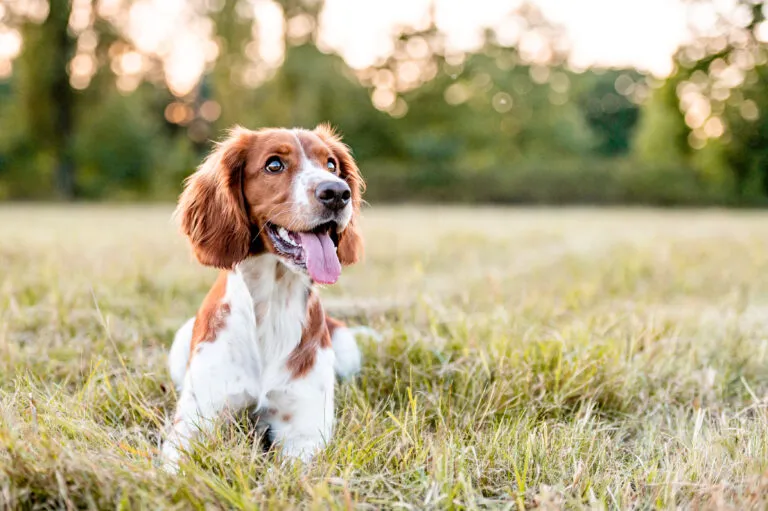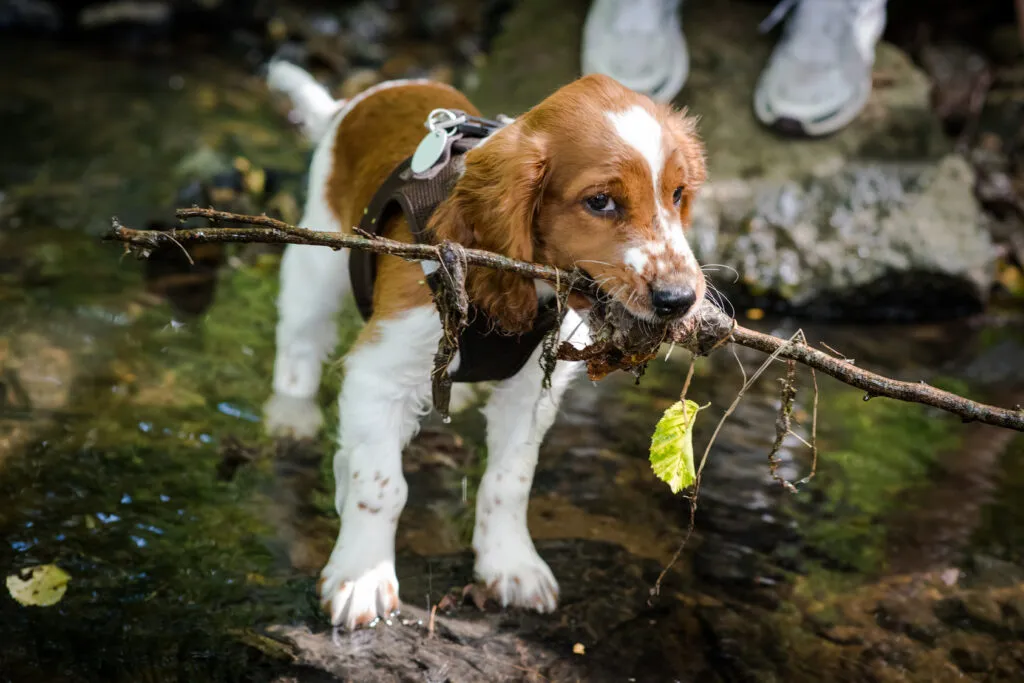Medium Size Poodle
The Welsh Springer Spaniel is one of the oldest hunting dogs in Great Britain and is still used today as a retriever and flushing dog. Alongside this, the lively, red-and-white furball is also a loyal and friendly family dog, bringing plenty of energy and joy to daily life.

© Eliška / stock.adobe.com
With plenty of exercise, Welsh Springer Spaniels become affectionate and well-suited family companions
The most distinctive feature of the Welsh Springer Spaniel is undoubtedly its fur colour. The rich red against silky, gleaming white fur is unique among Spaniel breeds. The hair is medium-length, dense, straight, and reliably repels dirt. The ears, chest, belly, and legs are particularly densely furred.
The Welsh Springer Spaniel reaches a max. shoulder height of 48cm, placing it just within the medium-sized dog breeds category. It is slightly smaller than its close relative, the English Springer Spaniel.
The Welsh’s body is a bit sturdier and more compact than that of the English version. Despite its robust build, the Welsh never appears clumsy. Its max. weight is 15kg, with females usually being slightly smaller and lighter.
Like other Spaniel breeds, the Welsh Springer Spaniel has the characteristic drooping Spaniel ears. They are set relatively low and taper to a point, resembling the shape of a vine leaf. They are moderately long and slightly wider than those of the English Cocker Spaniel.
The “typical Spaniel” look also includes gentle eyes, which are almond-shaped and can range from hazel to dark brown.
The Welsh Springer Spaniel seems never to know a bad mood. This cheerful, alert, and life-loving little Welshman with the distinctive red-and-white fur traverses the world with constant enthusiasm.
Always ready for play, it loves retrieving, swimming in any weather, and enjoying long, varied walks with the family. It enjoys human company immensely and feels happiest when it can be included in all activities. Extended loneliness would likely turn this lively character into a sorry little creature.
Those wanting to adopt a Welsh Springer Spaniel should especially bring two things: 1. Time and 2. The desire to engage extensively with the Welsh.
 © Frank Gärtner / stock.adobe.c
© Frank Gärtner / stock.adobe.c
Having been originally bred solely as a working hunting dog, the Welsh Springer Spaniel still needs meaningful activities and sufficient exercise today.
Its enthusiasm and endurance in tackling tasks are remarkable. Whether during hunting, dog sports or simply outdoors in the forest, fields, and water: the Welsh Springer Spaniel thrives everywhere. What matters most is that it can fully expend its energy while also engaging its mind.
Physical and mental exertion is not only vital for the fitness of the Welsh but also for a harmonious living environment.
The many positive traits of the Welsh can only shine if it can express its lively nature and its play and movement instincts. Only a Spaniel that is mentally and physically challenged appropriately will appear balanced at home.
A well-exercised Welsh Springer Spaniel proves to be a diligent and obedient student in training. Thanks to its intelligence and eagerness to please, it cooperates willingly.
Commands and tricks are picked up swiftly, and even its strong hunting instinct generally doesn’t pose a problem. However, like all dogs, training should be conducted with loving consistency. At inconsistent behaviour or excessive harshness, the intelligent Welsh might become stubborn.
If the Welsh Springer Spaniel is your first dog, it’s essential to acquaint yourself with the basic rules of dog training beforehand.
To minimise vet visits, good grooming is essential for your dog. Like all Spaniel breeds, the Welsh Springer Spaniel’s hair should be regularly trimmed. Every two months, hair around the paws, ears, rod, and neck should be shortened. To maintain its shine and structure, the fur should also be thoroughly brushed once or twice weekly.
It’s also important to regularly check the eyes, paws, ears, and teeth of your dog and clean them as needed. If you notice changes or initial signs of inflammation, you should schedule an appointment with your vet.
As crucial as good grooming is a good and balanced diet. Although the Welsh Springer Spaniel generally has no special dietary requirements, food that supplies the right quantity of nutrients and vitamins is essential for it too.
Some Spaniels are prone to overweight and should, therefore, never receive more than the recommended daily amount. Make sure to account for treats in between. Fresh drinking water should always be available.
In general, Welsh Springer Spaniels are very uncomplicated and robust dogs. Their diet, grooming, and training typically pose no problem, making them well-suited for beginners.
However, as the owner, you should always bear in mind that your dog, originally bred as a hunting, flushing, and retriever dog, has specific needs. Regular and varied activities that challenge your dog both physically and mentally are essential for the satisfaction of your Welsh.
Plan on dedicating at least two hours a day to your dog’s activities – especially if you’re keeping it as a family pet rather than a hunting dog.
A house with a garden is ideal for this active dog. However, with sufficient exercise, it can also feel comfortable in a reasonably-sized apartment.
If the Welsh Springer Spaniel is introduced to cats from an early age, cohabitation is possible. Small animals might pose a challenge due to its pronounced hunting instinct.
Your Spaniel will enjoy long, varied walks where new routes are explored. It also loves having the chance to jump into the water.
Play should not be neglected: let it retrieve dog toys or practice tricks. Suitable dog sports include agility or dog dancing. Tracking or hunting tests are also great ways to keep your dog fully engaged.
Intensive engagement with your dog will also positively impact the bond and mutual trust between you – vital for harmonious coexistence with your Welsh Springer Spaniel.
Welsh Springer Spaniels are known to be very healthy and robust dogs. While hereditary eye diseases, hip dysplasia, and typical Spaniel illnesses like Familial Nephropathy (FN) and Canine Fucosidosis also occur occasionally in this breed, they generally do not pose significant issues.
 © GT-Films / stock.adobe.com
© GT-Films / stock.adobe.com
Today, the Welsh Springer Spaniel, which was officially recognised as its own distinct breed by the Kennel Club in 1902, is primarily bred as a flushing and retriever dog.
Despite its excellent traits and attractive looks, the Welsh Springer is less common compared to other Spaniel breeds. Finding a breeder nearby can, therefore, be challenging for interested buyers.
Officially recognised Spaniel clubs or associations are usually a good starting point to get an overview of reputable breeders and current litter numbers. Even if the breeder with the next expected litter is further away, it is essential to have a personal meeting before purchasing.
Visit the breeder’s home to see the breeding environment, dogs, and rearing practices firsthand. Conversations with the breeder about the breed’s traits and behaviour can provide insights that no book or online description can replace.
Buy only from a breeder you like and whose credibility you trust. Ask to see the necessary health certificates and ensure that the breeder has been inspected and approved by an independent breeding supervisor.
A good indication of a recognised and reputable breeding site is the Fédération Cynologique Internationale (FCI) logo on the dog’s papers.
While it has never achieved the popularity of the Cocker Spaniel, the Welsh Springer Spaniel has been around for nearly 400 years. Its characteristics, hunting instincts, and appearance have remained largely unchanged over this time. It is considered one of the oldest hunting dogs in Great Britain and one of the most original.
Cynologists regard the Springer Spaniel as the ancestor of all Spaniel varieties. Illustrations from the 17th century show that such a dog type already existed on the British Isles, particularly in Wales.
For a long time, all Spaniel varieties in Great Britain were collectively referred to as “Field Spaniels”. From 1803, they were subdivided into “Springing Spaniels” and “Cocking Spaniels” based on their hunting style.
The term “Springer”, still present in the breed’s name today, derives from the English description of its hunting role. “To spring game into open” meant it flushed game out of hiding, making it easier for hunters to catch it in open fields or nets.
Fans of the Bearded Collie agree that those who aren't familiar with this dog breed simply have to get acquainted with it. And those who have experienced how a Bearded Collie bolts across meadows with its flowing fur, how it rolls around full of energy and joy and how it attentively and observantly takes into account its owners wishes become simply addicted to this original dog breed and its unique charm.
The Goldendoodle isn't a breed, but a pairing between Golden Retrievers and Medium or Standard Poodles. Marketed as a low-maintenance dog for allergy sufferers, this hybrid is enjoying increasing popularity amongst dog lovers, similar to the Labradoodle.